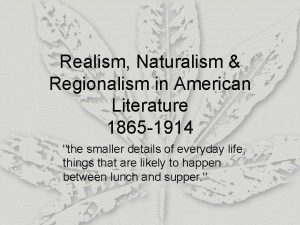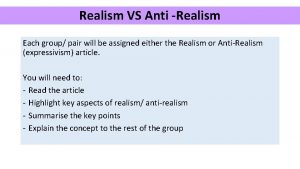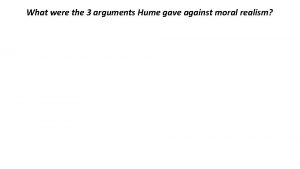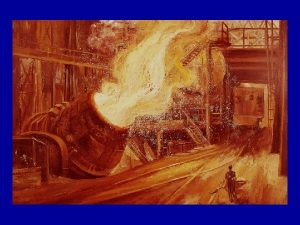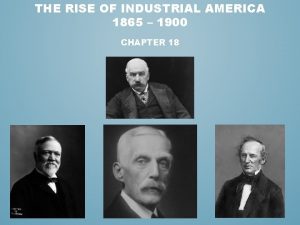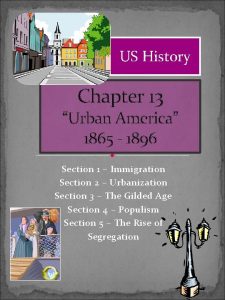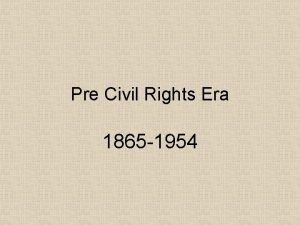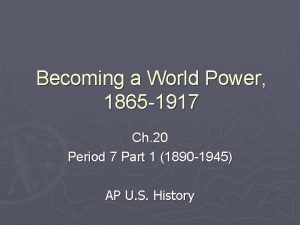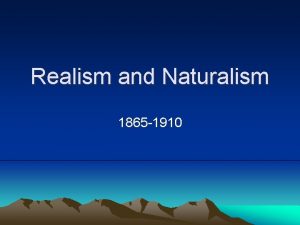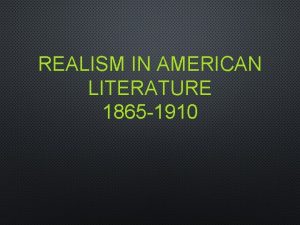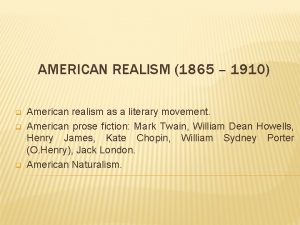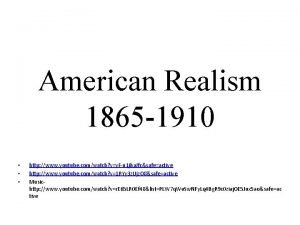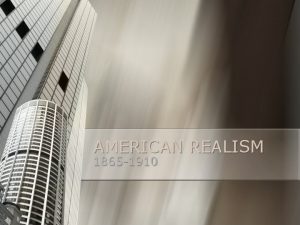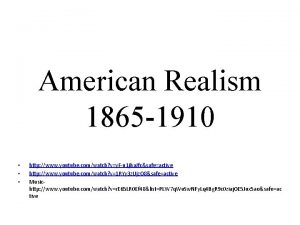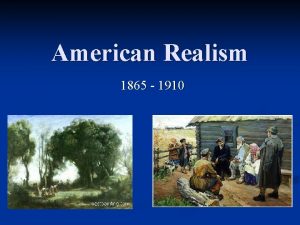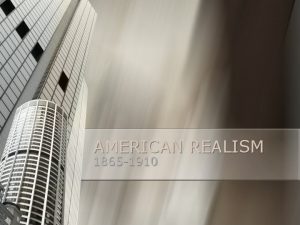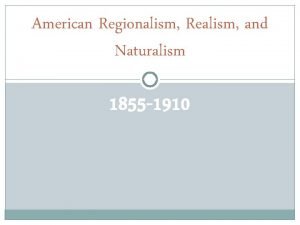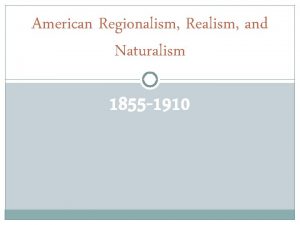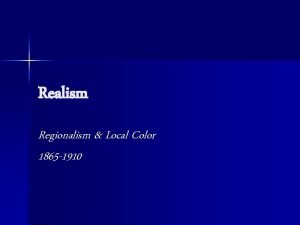American Realism 1865 1910 American Realism in context














- Slides: 14

American Realism 1865 -1910



American Realism in context of past and competing movements Genre American Author Perceived the individual as. . . Romantics Ralph Waldo Emerson a god Realists Henry James William Dean Howells Mark Twain simply a person Naturalists Stephen Crane Frank Norris a helpless object

What is Realism? �A faithful representation of reality in literature, also known as “verisimilitude. ” �Emphasis on development of believable characters. �Written in natural vernacular, or dialect.

Realist Writers �Mark Twain �William Dean Howells �Henry James �Edgar Lee Masters �Ambrose Bierce �Kate Chopin

Why did Realism develop? �The Civil War �The urbanization and industrialization of America �As a reaction to Romanticism �Increasing rates of democracy and literacy �The emerging middle class

Beat! Drums! (1861) Beat! beat! drums!—blow! bugles! blow! Through the windows—through doors—burst like a ruthless force, Into the solemn church, and scatter the congregation, Into the school where the scholar is studying, Leave not the bridegroom quiet—no happiness must he have now with his bride, Nor the peaceful farmer any peace, ploughing his field or gathering his grain, So fierce you whirr and pound you drums—so shrill you bugles blow.

A Sight in Camp in the Daybreak Gray and Dim (1862) A sight in camp in the daybreak gray and dim, As from my tent I emerge so early sleepless, As slow I walk in the cool fresh air the path near by the hospital tent, Three forms I see on stretchers lying, brought out there untended lying, Over each the blanket spread, ample brownish woolen blanket, Gray and heavy blanket, folding, covering all. Curious I halt and silent stand, Then with light fingers I from the face of the nearest the first just lift the blanket; Who are you elderly man so gaunt and grim, with well-gray'd hair, and flesh all sunken about the eyes? Who are you my dear comrade? Then to the second I step--and who are you my child and darling? Who are you sweet boy with cheeks yet blooming? Then to the third--a face nor child nor old, very calm, as of beautiful yellow-white ivory; Young man I think I know you--I think this face is the face of the Christ himself, Dead and divine and brother of all, and here again he lies.

Characteristics of Realism � Realists take their subject matter from ordinary life. Realists were influenced by the spread of democracy in Europe and North America. Middle and lower class citizens were becoming increasingly important. Detailed settings became important as a means of establishing the realistic nature of main characters and places. Dialect became popular as did an emphasis on local color. � Realists placed an emphasis on characters. As democracy spread, so did the importance of the individual. As individuals became more important in the “real” world, characters became more important in Realist literature. Character, not plot, is the essence of Realism. � Realists concern themselves with ethical issues. As with all literature, the conflict often involves a moral dilemma faced by one of its participants. With Realism, this dilemma has to be portrayed accurately, honestly, and in detail. Realists avoid preachiness.

Structure of Prose �Diction is the natural vernacular, not heightened or poetic; tone may be comic, satiric, or matter-of-fact. �The use of symbolism is controlled and limited; the realists depend more on the use of images. �Objectivity in presentation becomes increasingly important: overt authorial comments or intrusions diminish as the century progresses.

Principles of Realism � 1. Insistence upon and defense of "the experienced commonplace". � 2. Character more important than plot. � 3. Attack upon romanticism and romantic writers. � 4. Emphasis upon morality often self-realized and upon an examination of idealism. � 5. Concept of realism as a realization of democracy.

Realistic Techniques � 1. Settings thoroughly familiar to the writer � 2. Plots emphasizing the norm of daily experience � 3. Ordinary characters, studied in depth � 4. Complete authorial objectivity � 5. Responsible morality; a world truly reported (Compare with Romantic Techniques)

Discuss and develop authorial claims: �Group 1/5: Why does the verb tense change from past tense to present tense in the second to last paragraph? �Group 2/6: The story demonstrates the protocol and enactment of military justice. Is Bierce commenting on military law? �Group 3/7: What control does Farquhar have over his own destiny? �Group 4/8: How does Bierce depict nature in this story? What role does it play? It’s significance?
 Regionalism american literature
Regionalism american literature Realism vs anti realism
Realism vs anti realism No moral
No moral Briefly summarise
Briefly summarise Becoming a world power 1865-1917
Becoming a world power 1865-1917 Gregor mendel 1865
Gregor mendel 1865 Industrialization (1865 to 1901 worksheet answers key)
Industrialization (1865 to 1901 worksheet answers key) Four features of industrial manufacturing (1865-1900)
Four features of industrial manufacturing (1865-1900) Traits of impressionism
Traits of impressionism Urban america 1865 to 1896
Urban america 1865 to 1896 1865 to 1900 inventions
1865 to 1900 inventions 15 th ammendment
15 th ammendment Where did the term impressionism come from
Where did the term impressionism come from Chapter 20 becoming a world power notes
Chapter 20 becoming a world power notes Hollywood silver fox farm v emmett
Hollywood silver fox farm v emmett
